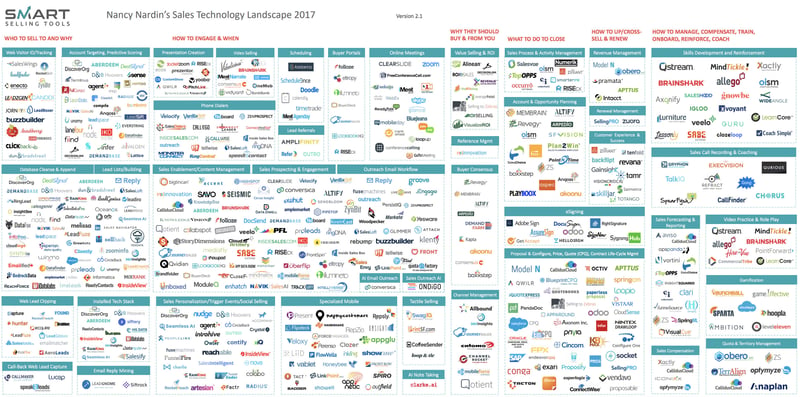
Is the Sales Stack Destroying Your Effectiveness?
Technology was supposed to make our lives easier, and our teams more effective. Somehow, however, most sales teams are still caught in the same old traps as ever, just with new toys.
We have the ability to listen in and record sales calls, to record minute details about every contact, to send messages instantaneously and search our inboxes for old messages. We can call up detailed information about each contact’s preferences, what white papers they’ve read, and even which competitor’s websites they’ve visited. We get notifications when they open our emails, and we might even know what brand of cologne they wear and when they last bought some.
We literally know what our prospects smell like, but somehow, we, as an industry, can’t seem to improve our overall effectiveness year over year.
Is it possible that all the technology we’ve piled on top of technology is part of the problem rather than the solution? I think it is, and the data agrees.
Increased complexity = decreased effectiveness
A recent study from Gartner revealed that sellers working in organizations with complex “sales enablement” systems, on average, experience a lower conversion rate than those that don’t. This is not how sales enablement is supposed to work!
Part of the problem, according to the same study, is that as a company moves from low internal complexity to higher internal complexity, the burden on sellers increases by as much as 62%. That’s 62% of time that could be devoted to moving sales instead of interacting with complex systems on top of other systems.
In most cases, sales organizations are not taking a strategic approach to the addition of sales technologies. Instead, they see a problem and they seek out a technology to address it. This approach results in a “sales stack” that truly operates as a stack, rather than as a coordinated system.
In other words, you end up with dozens of technologies and systems stacked on top of one another, through which each salesperson and sales manager must learn how to use to access the specific information or function they need.
And the problem is only getting worse, as more technologies are added to the marketplace daily. Consider this chart by Nancy Nardin, which identifies only the biggest players in each of the sales technology areas.

Undoubtedly, more technologies have entered the industry since the chart was published only a few months ago, and it’s only going to get worse.
Stop the sales stack madness!
Organizations are throwing away insane amounts of money and time at technologies that at best fail to move the needle and at worst decrease effectiveness. Then they’re hiring more people to manage the technologies, adding to the complexity and the cost burden of the technology stack.
This is madness!
Part of the problem is that the “original” sales technology, the CRM, was not built with effectiveness in mind. It was built as a reporting tool for managers to use to control their salespeople. And it was designed based on the assumption that salespeople know how to sell and should only “log what they have done”. In order to make them work as effectiveness tools, old CRM systems like Salesforce at best require plugins and at worst require costly customization.
But the deeper problem is that organizations are not approaching sales technology in a strategic manner. Rather, we tend to buy what everyone else is buying or that promises to fix a particular problem we want to solve, without first asking whether the technology will support our strategy and make it easy to execute.
How to align your technology with your strategy
A well-designed sales technology environment reduces burden on salespeople, streamlines their workflow, and makes it easy for them to execute on sales strategy. In short, it improves rather than inhibiting effectiveness.
To determine the best technologies for your sales team, consider where your sales environment falls on the complexity spectrum. Transactional sales require an entirely different strategy, and therefore technology, than complex sales.
Then, make sure the backbone of your technology stack makes it easy for salespeople to follow your sales process and access everything they need in order to do their jobs, all in one simple, intuitive workflow.
Finally, only add new technologies if your strategic vision calls for it, and make sure they will help drive the behaviors you need to succeed. Avoid the temptation to add new functionality that forces salespeople and managers to operate out of multiple systems in the course of a day. Even though they all “neatly integrate with your CRM” according to the marketing materials.
For most complex sales environments, I believe Membrain is the best platform for building a truly effective, streamlined sales enablement technology system. Check out how our customer Analitek doubled their quota attainment and book your demo today.

By George Brontén
George is the founder & CEO of Membrain, the Sales Enablement CRM that makes it easy to execute your sales strategy. A life-long entrepreneur with 20 years of experience in the software space and a passion for sales and marketing. With the life motto "Don't settle for mainstream", he is always looking for new ways to achieve improved business results using innovative software, skills, and processes. George is also the author of the book Stop Killing Deals and the host of the Stop Killing Deals webinar and podcast series.
Find out more about George Brontén on LinkedIn







